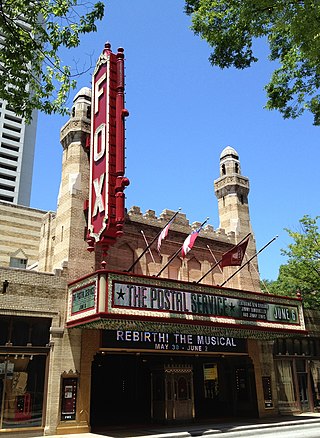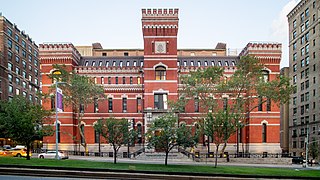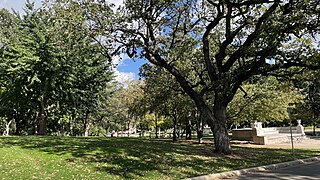
Georgia State University is a public research university in Atlanta, Georgia. Founded in 1913, it is one of the University System of Georgia's four research universities. It is also the largest institution of higher education by enrollment based in Georgia and one of the largest in the nation with a student enrollment of around 50,000, including approximately 33,000 undergraduate and graduate students at the main campus downtown.

The Tabernacle is a mid-size concert hall located in Downtown Atlanta, Georgia. Opening in 1911 as a church, the building was converted into a music venue in 1996. It is owned and managed by concert promoter Live Nation Entertainment and has a capacity of 2,600 people.

The Fox Theatre, a former movie palace, is a performing arts venue located at 660 Peachtree Street NE in Midtown Atlanta, Georgia, and is the centerpiece of the Fox Theatre Historic District.

Technology Square, commonly called Tech Square, is a multi-block neighborhood located in Midtown Atlanta, Georgia, United States. Tech Square is bounded by 8th Street on the north, 3rd Street on the south, West Peachtree Street to the east, and Williams Street to the west. Tech Square includes several academic buildings affiliated with Georgia Tech and provides access to the campus via the Fifth Street Pedestrian Plaza Bridge, reconstructed in 2007. It also contains restaurants, retail shops, condominiums, office buildings, and a hotel.

Junior's Grill was a restaurant in Atlanta, Georgia, in the United States. It was located on the Georgia Tech campus in the Bradley Building near Tech Tower. It was a family business owned by Tommy Klemis. The restaurant served breakfast, lunch and dinner Monday through Thursday, and was famous among students for its French toast and battered chicken fingers. It closed on April 21, 2011, due to declining business.
The Kimball House was the name of two historical hotels in Atlanta, Georgia. United States. Both were constructed on an entire city block at the south-southeast corner of Five Points, bounded by Whitehall Street, Decatur Street, Pryor Street, and Wall Street, a block now occupied by a multi-story parking garage.
Georgia's 5th congressional district is a congressional district in the U.S. state of Georgia. The district was represented by Democrat John Lewis from January 3, 1987, until his death on July 17, 2020. Kwanza Hall was elected to replace Lewis on December 1, 2020, and served until January 3, 2021, when Nikema Williams took his place. Hall was elected in a special election for the balance of Lewis' 17th term. He chose not to run in the general election for a full two-year term, which was won by Williams.

The Miami Beach Convention Center is a convention center located in Miami Beach, Florida. Originally opened in 1958, the venue was renovated from 2015 to 2018 for $620 million. The re-imagined and enhanced MBCC includes a 60,000-square-foot Grand Ballroom, four junior ballrooms, 500,000 square feet of flexible exhibition space, 84 meeting rooms, and pre-function space, as well as outdoor spaces and terraces.

The Park Avenue Armory, also known as the 7th Regiment Armory, is a historic National Guard armory building at 643 Park Avenue in the Upper East Side neighborhood of Manhattan in New York City. Designed in the Gothic Revival style by Charles Clinton for the 7th New York Militia Regiment, the Park Avenue Armory was completed in 1880, with two expansions in the early 20th century. The building and its interior are New York City designated landmarks, and the structure was made a National Historic Landmark in 1986. Since 2006, it has been the home of the Park Avenue Armory Conservancy, which leased the building for 99 years from the New York state government. The 53rd Digital Liaison Detachment of the New York Army National Guard, the Veterans of the 7th Regiment, the Knickerbocker Greys cadet corps, and the Lenox Hill Neighborhood House also occupy parts of the armory.
The College of Design at the Georgia Institute of Technology, established in 1908 as the Department of Architecture and also formerly called the College of Architecture, offered the first four-year course of study in architecture in the Southern United States.

The University of Minnesota Old Campus Historic District is a historic district located in Minneapolis, Minnesota. Listed in the National Register of Historic Places since 1984, it includes a number of historic buildings that were constructed during the late 1800s and early 1900s, and represents the oldest extant section of the University of Minnesota campus. The general area was designed by landscape architect Horace W. S. Cleveland, who envisioned a park-like University. His plan, that he presented to the Board of Regents, went on to help form the Historic District. It is located directly to the north of the University's Northrop Mall Historic District.

The Ferst Center for the Arts, located in Atlanta, Georgia, is Georgia Tech's theater and arts center and is adjacent to DramaTech, the student-run theater. It contains a 950-seat auditorium that features a proscenium stage, orchestra pit, and theatrical lighting and sound systems.

First Church of Christ, Scientist is the main congregation for Atlanta, Georgia’s Christian Science community. Its historic Greek revival church edifice is located on the corner of Fifteenth Street, N.E., and Peachtree Street in the city's Midtown section and is a contributing property in the Ansley Park Historic District.

Ponce City Market is a mixed-use development located in a former Sears catalogue facility in Atlanta, with national and local retail anchors, restaurants, a food hall, boutiques and offices, and residential units. It is located adjacent to the intersection of the BeltLine with Ponce de Leon Avenue in the Old Fourth Ward near Virginia Highland, Poncey-Highland and Midtown neighborhoods. The 2.1-million-square-foot (200,000 m2) building, one of the largest by volume in the Southeast United States, was used by Sears, Roebuck and Co. from 1926 to 1987 and later by the City of Atlanta as "City Hall East". The building's lot covers 16 acres (65,000 m2). Ponce City Market officially opened on August 25, 2014. It was listed on the National Register of Historic Places in 2016.

The Ivan Allen Jr. Braves Museum and Hall of Fame (BMHF) was founded in 1999, to honor various players, managers, coaches, executives, and others who have been a part of the Atlanta Braves professional-baseball franchise during its years in Boston (1871–1952), Milwaukee (1953–1965), and/or Atlanta (1966–present). The Museum and Hall of Fame, named after former Atlanta mayor Ivan Allen Jr., was located in Turner Field on the northwest side at Aisle 134.

The Hartington City Hall and Auditorium, also known as the Hartington Municipal Building, is a city-owned, brick-clad, 2-story center in Hartington, Nebraska. It was designed between 1921 and 1923 in the Prairie School style by architect William L. Steele (1875–1949).

John Robert Dillon was an architect active in Atlanta, Georgia. He became associated with the Bruce and Morgan firm in 1903, which became Morgan and Dillon in 1904. A graduate of Northwestern School of Architecture, he was named a Fellow in the American Institute of Architects in 1948.

The Paramount Theatre was a movie palace in downtown Atlanta, Georgia, United States. The building was designed by Philip T. Shutze and was completed in 1920 as the Howard Theatre, a name it kept until 1929. It was located at 169 Peachtree Street, in an area that soon became the location of several other major theaters, earning it the nickname "Broadway of the South". With a seating capacity of 2,700, it was at the time the second largest movie theater in the world, behind only the Capitol Theatre in New York City. In addition to functioning as a movie theater, the building hosted live performances, with several nationally renowned orchestras playing at the venue through the 1940s and Elvis Presley playing at the theater in 1956. By the 1950s, however, movie palaces faced increased competition from smaller movie theaters and the rise in popularity of television, and the Paramount was demolished in 1960.
The East Point Historic Civic Block consists of three historically significant buildings and one memorial park in downtown East Point, Georgia, and is located within the parameters of East Point Street, Linwood Avenue, Church Street, and West Cleveland Avenue. East Point's City Hall, City Auditorium, New Deal Library, and Victory Park make up the Civic Block, which since 2011 has been the focus of both redevelopment interest and historic preservation efforts.

Broadway Auditorium is a former multipurpose arena in Buffalo, New York. It was part of a complex that first opened as Broadway Arsenal in 1858 to accommodate the 65th and 74th Regiments of the New York National Guard. The facility was expanded in 1884 with the addition of a drill hall and administration building to become the Sixty-Fifth Regiment Armory. The armory was decommissioned in 1907, and the City of Buffalo opened the vacant drill hall as Broadway Auditorium in 1913.

















